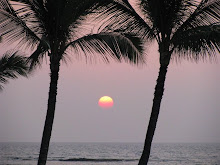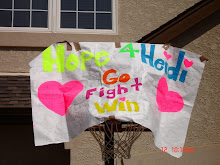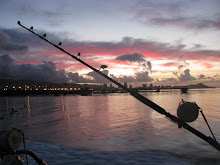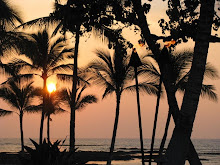Below is Steve's amazing and awe inspiring account of his race. As you read, you will see that an Ironman is nothing to be taken lightly, people literally die competing in these things. Thank you again, Steve, you have lightened Heidi's heart and inspired all of us that know about this. I've never been much of a runner, or a biker or swimmer for that matter, but next year I'll make it if I can...maybe they will have a beach volleyball tournament to accompany the race next year. I hope you qualify for the Kona race in the 45's. It would be hard to keep me away from that!
======Begin Steve's 2 part message...=======
Ironman Canada Race Day -- August 30
The Ironman for Heidi project is one of those rare, great life experiences. And as an added bonus, it just happens that this experience has given me more than I have given it. Though I did donate 7834 burned calories to the effort yesterday.Let’s start the story of the Ironman with the day after the Ironman. Because today I learned just how lucky I was to finish.
I awoke and limped to the bathroom, where my legs objected to the squatting motion necessary to sit on the toilet. So I stood a couple feet further in front of the toilet than is usual and fell back, catching the toilet seat behind me, then executing a triceps press into the seated position. My stomach muscles screamed for mercy.
After a cup of coffee, I checked out my bike and realized that my rear tire had gone completely flat. This same tire held air all throughout the 112 mile bike-leg yesterday. I then flipped through the newpaper account of the race and learned that a man died during the swim. So, already, by any measure, I was fortunate yesterday. Here’s how it unfolded.
At 3 a.m. on race morning, I executed my normal pre-race routine -- 3 Boosts, a bottle of Gatorade and one very strong cup of coffee. The goal is to use the facilities before the race, because, while most Ironman competitors think nothing of peeing themselves during the race, we generally draw the line at solids.I got to the transition early and headed over to put on my wetsuit, pump up my tires and get body marked (this is where they write your race number on your arms with magic marker so that they can identify the body, quite literally). I asked the woman with the felt-tip to upgrade my “4 Heidi” tattoo while she was at it. She asked about Heidi and wished her well.
Before heading to the water for a warm-up swim, I stumbled into Jeri and Monica, two women who are on the same club team as me. I helped them put on their wetsuits and we started walking towards the beach. We walked past a line of competitors who were waiting to use the porta potties, so I asked my friends whether they needed to make a pit stop before we headed for the lake. Monica said: “I’m peeing right now”. I love this sport.
The swim start is perhaps the most impressive spectacle in Ironman racing. Because all 2600 athletes start at once, the starting line is perhaps 300 yards wide and 20 rows deep. Everyone futilely looks for that special starting spot where they can avoid the hand-to-hand fighting that is part of the Ironman swim start. But I have learned that there is no avoiding the contact of the swim start. So rather than wasting time trying to avoid it, I decided to confront it head-on. I seeded myself in the front row, in the middle, knowing that a few hundred faster swimmers would provide me an opportunity to swim faster in their substantial current. Unfortunately, those same swimmers would beat me to a pulp as they raced for the front of the pack.
“Maranatha”, the Ironman Canada cannon fired, and I immediately dove in and began swimming for my life. The contact was immediate and personal. I may have accidentally fathered a couple children in the first two hundred yards -- or I may now be gay. It’s hard to say. As always, the water became less congested after the turn-around at the 1.2 mile mark. I followed some big feet with a red timing chip strap most of the way back to shore and exited the water in 1 hour 8 minutes and some change.
I transitioned to the bike and was moving along briskly for the first 35 miles. Unfortunately, the fun ended there as I hit the first 1500 foot climb at Richter Pass, riding with about 15 guys and gals going roughly the same pace as me. Most of the group shot up the climb like they were riding the Tour de France. I rode conservatively at the back, in part because I had to pee and didn’t want to douse anyone, and in part because I was fearful of turning the marathon into a 26 mile walk.After cresting the pass, I put my nose on the front wheel and quickly had the speedometer pegged at 45 mph on the steep 5 mile downhill. One by one, I caught my hard working friends before the bottom and we reformed our group, minus a few timid souls who rode the brakes down the hill. I must have really nailed my hydration, because I had pee again (the second time is always easier. You’re not worried about being covered in urine, since you are already covered in urine).
It was at this point that we noticed trouble in the wind, literally. The wind was blowing at about 30 mph from the west directly at us, which in and of itself sucked, but we were really worried about the eye watering smoke that the wind was pushing into the valley. There are 200 forest fires raging near the Okanagan Valley and the wind had shifted -- in a bad way. We soldiered on, taking shallow breaths, as we rode over an endless series of rolling hills and finally, 20 miles from end of the bike, up the dreaded Yellow Lake Pass. Yellow Lake is a 7-mile, 1500 foot climb, the last really tough stretch before the descent back to Penticton.
Having ridden conservatively to this point, I felt remarkably strong going up Yellow Lake. And with the energy supplied by hundreds of spectators lining the road on the steepest part of the climb, the ascent was not entirely unbearable.After the climb, I still had plenty left in the tank and was riding at a good clip on the flats back into town, when I was caught by a guy named Doug.Being the only survivors from the original group of fifteen and with our bike-to-run transition just a couple miles away, Doug and I allowed ourselves a brief moment of human interaction. We rode side-by-side through town with fans lining both sides of Main Street, Penticton, soaking up the cheers of the crowd. We were smiling at each other, and Doug was saying that he was glad to be done with the bike-leg, when suddenly, a small child jumped from the crowd into the road directly into Doug’s path. There was no time to stop. I heard Doug shout, “Watch...!” The rest was cut off by the sickening sound of Doug’s bike smashing to the ground. By the time I slowed down and looked back, a number of people, including race officials who were guarding the intersection, were surrounding the crash and it was impossible to tell how badly he was injured. I considered going back, but it was clear that there was nothing for me to do. Another group of riders came up from behind and I made the difficult decision to get moving again.
=====Part 2=====
I rode into what we call T2 (the transition two -- the first being the swim to bike transition -- T1), with a 5 hour 22 minute bike split. I expected to go about 5:20, so in the world of day long races, I was right on time. I needed to run a 3:30 marathon to finish in 10:05 -- a stretch -- but a 3:45 marathon seemed achievable.With that thought in mind, I threw on my running shoes and began the marathon.
I hoped that my conservative bike ride would translate into a solid 8 minute per mile run pace. And it did -- for two miles. Then it settled into something in the 9:00 to 9:30 per mile range and no amount of effort would allow me to run faster. Even peeing didn’t help. It just soaked my socks, making them squishy and uncomfortable. On the other hand, I seemed to have good endurance and I was confident that I could make up ground on my competitors by being consistent, if not fast.
Sure enough, at mile 10 I began catching and passing a number of the gazelles who had sprinted out of T2. Some were walking, others were enjoying time in the porta potties and still others were bent over the guard-rail ridding themselves of GU’s, Gatorade and whatever else wasn’t digesting. I trotted along like this for mile after mile after mile. That is, until mile 22. Mile 22 for a marathon runner is a dark place. It is at this point in a marathon when many “hit the wall”. But in an Ironman, mile 22 of the marathon means nothing. It’s 136 miles into the race. Everything hurts and life has sucked for a very long time. In fact, mile 22 of the marathon is so close to the finish that some people get their second wind at this point. But at mile 22 of this marathon, I slammed into the supposedly non-existent wall so hard I almost broke my face.
It all started when the standard-Ironman-issue searing pain in my quads warned me of an impending cramp. So trying to stave off quad cramps, I changed my running style to shift the work to my hamstrings, which had the effect of causing pain in my left knee. To alleviate that pain, I adopted yet another running style, landing more on my forefoot. And that’s when a little known muscle tucked behind the achilles tendon cramped so hard it almost felled me. I gingerly walked a few steps and found that those achilles muscles didn’t mind walking -- they just hated running.
By this time, my original time goals were not achievable due to my slower than expected marathon, but there was no way I was going to miss out on finishing under 11 hours -- unless, of course, I couldn’t run. In which case it didn’t matter that I had over 50 minutes to travel a mere 4 miles. I couldn’t make.I took a deep breath and looked at my arms. “4 Heidi” was why I was here and I knew then that it didn’t matter when I finished, just that I needed to finish. I instantly felt calm and more relaxed than I had been all day. And as I continued to walk I could feel the cramps easing. After a minute or two, I tested out a jog. And then, almost like an out of body experience, the jogging began to feel like floating, literally like running on a cushion of air. From that point on, whenever I started to feel tense, I would look at my arm and that would calm my mind, and the mind would do what the body couldn’t.
I easily ran the next two miles in under 20 minutes and knew I would have no trouble finishing in under 11 hours. I was inspired and relaxed and nothing would stop me.About the time, I ran up behind one of my competitors who was walking. His name was Josh and he was clearly in bad shape. As I ran by, I said “come on, let’s finish this”. This is a pretty common thing to say, but generally the response is “I can’t run because of _______”.
Josh looked up and said “let’s do it”, and began running beside me. We spent the next couple miles chatting and encouraging each other, all the while working our way closer and closer to the finish line. As we broke the tape and were caught by a couple volunteers, we cemented our friendship with a sweaty hug and a picture.It was a great way to end the day. It ended just the way it started, inspired by friends, first the old, then the new.
For the record, I finished in 10 hours 54 minutes and 7 seconds. John Davis wins the Ipod with a prescient guess of 10:53:20. Brett Warta finished second, winning the Canada Speedo prize, which is fortunate, since he may be the only other person who fits into a size 28 banana hammock. Honorable mention goes to my old fraternity buddy Otto Koerner as well as Todd Renard and Barbara Kelly who all made guesses within about 4 minutes of my finishing time.And also for the record, in the never-say-die spirit of the Ironman, Doug not only remounted his broken bike and made it to T2, he strapped on his running shoes and finished the race.Thanks everyone.
After I start walking again, maybe we'll talk about Ironman for Heidi II. The one where someone from this group joins me and straps on a matching speedo for charity. :) And yes, Kay. The picture will be on the way shortly.
=======END====
THANKS AGAIN STEVE!
Tuesday, September 1, 2009
Subscribe to:
Comments (Atom)


















